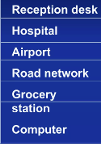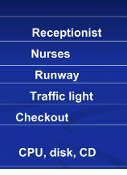LESSON 7: QUEUING THEORY
1/26
There's no tags or description
Looks like no tags are added yet.
Name | Mastery | Learn | Test | Matching | Spaced |
|---|
No study sessions yet.
27 Terms
Queuing theory
refers to the mathematical study of the formation, function, and congestion of waiting lines, or queues.
Queuing theory
It is extremely useful in predicting and evaluating system performance.
Someone or something that requests a service
usually referred to as the customer, job, or request.
Someone or something that completes or delivers the services
usually referred to as the server
Customers
refers to anything that arrives at a facility and requires service, e.g., people, machines, trucks, emails
Server
refers to any resource that provides the requested service, e.g., repairpersons, retrieval machines, runways at airport
System

Server

Customers

FIFO (First-In-First-Out)
Toll Booths – The first car in line pays and leaves before the next car.
FIFO (First-In-First-Out)
Checkout Queues – Customers at a supermarket checkout are served in the order they arrive.
FIFO (First-In-First-Out)
Traffic Signals – The first vehicle to stop at a red light moves first when it turns green.
FIFO (First-In-First-Out)
Drive-Thru Lanes – Orders are taken and served in sequence based on arrival time
LIFO (Last-In-First-Out)
Elevators – The last person to enter an elevator is usually closest to the door and exits first.
LIFO (Last-In-First-Out)
Aircraft Evacuation – Passengers seated near the exits (who may have boarded last) leave first.
LIFO (Last-In-First-Out)
Crowded Buses or Trains – Those who board last often stand near the doors and exit first.
LIFO (Last-In-First-Out)
Ferry Loading and Unloading – Vehicles or passengers that board last are positioned near the exit and leave first.
Deterministic
constant arrivals (time intervals)
Markovian
uneven intervals (exponentially distributed)
M/M/1 (∞)
random arrival and departure; single server; infinite queue (no limit).
M/M/N (∞)
random arrival and departure; N or multiple servers; infinite queue.
D/D/1 (100)
regular arrival; regular departure; single server; limit of queue is 100.
Arrival Rate (λ)
the rate at which the vehicles arrive at the queue point.
Departure Rate (μ)
the rate at which vehicles leave the queue point.
Departure Channel (C)
represents the number of servers/exits.
Traffic Intensity (ρ = λ/μ )
the ratio of the arrival to the departure rate.
Servers Limit (n)
represents the number/limit of queue servers.